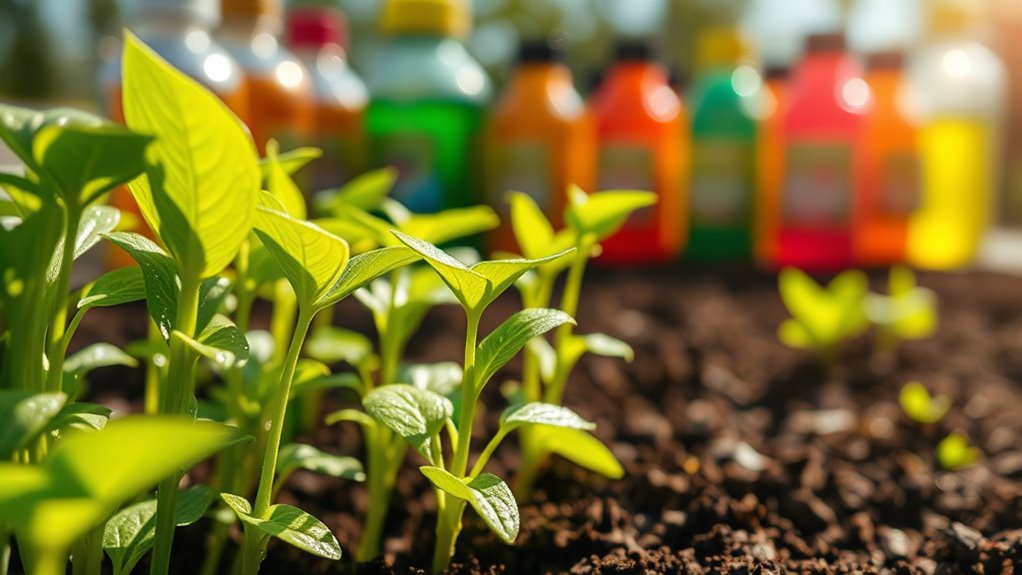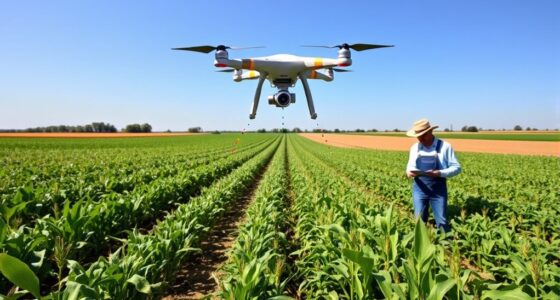Biostimulants play a essential role in boosting your plant’s growth and resilience by activating natural processes rather than just supplying nutrients. They improve root development, enhance nutrient uptake, and strengthen your plants against stresses like drought or pests. By promoting beneficial microbes and supporting soil health, they create a more sustainable growing environment. Keep exploring to discover how these powerful tools can help you optimize your crop production and health.
Key Takeaways
- Biostimulants activate plant internal processes, enhancing growth, resilience, and nutrient efficiency.
- They improve root development and water uptake, especially under stress conditions like drought.
- Biostimulants promote beneficial soil microbial activity, boosting soil health and nutrient availability.
- They support crop development and yield quality by strengthening plants against pests, diseases, and environmental stresses.
- Application flexibility allows tailored use via foliar spray, soil drench, or seed treatment, maximizing plant growth benefits.

Biostimulants have become increasingly important in modern agriculture because they enhance plant growth and improve crop resilience. When you apply these substances, you’re not just providing nutrients; you’re boosting the plant’s natural ability to thrive under various conditions. Unlike fertilizers that supply essential nutrients directly, biostimulants activate the plant’s internal processes, making growth more efficient and sustainable. This means healthier roots, stronger stems, and increased yields, even when environmental stresses like drought or poor soil quality threaten your crops.
Biostimulants boost plant resilience and growth by activating internal processes, leading to healthier crops under stress.
You’ll find that biostimulants work through multiple mechanisms. They stimulate enzymatic activities, enhance nutrient uptake, and promote the synthesis of essential compounds such as amino acids, vitamins, and hormones. This holistic approach helps plants develop better defense systems against pests, diseases, and abiotic stresses. For example, when you use biostimulants, your plants are better equipped to handle drought conditions because their roots become more efficient at extracting water, and their cellular processes adapt to conserve moisture. As a result, your crops remain healthier and more productive during challenging weather patterns.
Another key benefit is that biostimulants improve soil health over time. They encourage beneficial microbial activity, which in turn enhances nutrient availability and uptake. When you incorporate biostimulants into your farming practices, you’re fostering a more resilient and balanced soil ecosystem. This reduces the need for chemical inputs and promotes sustainable agriculture. Over time, this leads to improved soil structure, increased organic matter, and better water retention—benefits that directly translate into higher crop quality and yields.
Applying biostimulants is straightforward, and you can tailor their use to suit your specific crop needs. Whether you’re treating seedlings, boosting mature plants, or preparing for stressful weather, these products can be integrated into your regular fertilization routine. You might use foliar sprays, soil drenches, or seed treatments, depending on your goals. Because biostimulants work synergistically with existing nutrients, they maximize the efficiency of your overall fertilization strategy, reducing waste and lowering input costs.
Frequently Asked Questions
Can Biostimulants Replace Traditional Fertilizers Entirely?
You wonder if biostimulants can fully replace traditional fertilizers. While biostimulants boost plant health, nutrient uptake, and stress tolerance, they don’t provide the essential macronutrients plants need, like nitrogen, phosphorus, and potassium. You should use them as complementary tools alongside fertilizers, not substitutes. Combining both approaches ensures ideal growth, yield, and resilience, helping you maintain healthy, productive plants without risking nutrient deficiencies.
Are Biostimulants Safe for Organic Farming Practices?
Did you know that over 80% of organic farmers already use biostimulants? You can feel confident that biostimulants are generally safe for organic practices, as they’re derived from natural sources like plants, algae, or microorganisms. They enhance growth without synthetic chemicals, aligning with organic standards. So, if you’re committed to organic farming, incorporating biostimulants can boost your crop health while keeping your practices eco-friendly and compliant.
How Long Does It Take to See Results After Application?
You’ll typically see results within a few days to a couple of weeks after applying biostimulants. The exact timing depends on the type of biostimulant, plant species, and growing conditions. For example, some products promote quick nutrient uptake, showing effects in days, while others support longer-term growth, taking weeks to notice significant changes. Keep an eye on your plants and adjust applications as needed for ideal results.
Do Biostimulants Have Any Known Environmental Impacts?
Imagine you’re a modern-day alchemist pondering if biostimulants are eco-friendly. These products generally have minimal negative environmental impacts because they’re naturally derived and biodegradable, helping reduce chemical runoff and soil contamination. You won’t find them causing the ecological chaos of a lost civilization. Instead, they support sustainable agriculture, boosting plant health while safeguarding the environment, making them a wise choice for eco-conscious farmers and gardeners alike.
What Are the Economic Benefits of Using Biostimulants?
You’ll find that using biostimulants offers several economic benefits. They boost crop yields, which means you can harvest more produce from the same land, increasing your income. Additionally, biostimulants improve plant health, reducing the need for chemical fertilizers and pesticides, lowering your input costs. Faster crop growth shortens your growing season, enabling you to plant and harvest more frequently. Overall, biostimulants help you save money while maximizing your farm’s productivity.
Conclusion
In conclusion, biostimulants play a crucial role in boosting plant growth and health. Did you know that using biostimulants can increase crop yields by up to 20%? By enhancing nutrient uptake and stress tolerance, you can see healthier, more resilient plants. Incorporating biostimulants into your gardening or farming practices isn’t just beneficial—it’s a smart step toward more sustainable and productive growth. So, give them a try and watch your plants thrive!









